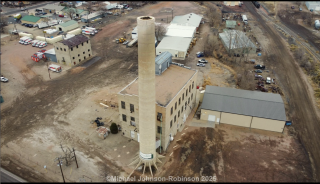The Story of Oil in Fremont County
Written and photos by Mike Johnson-Robinson and shared with his permission

Ariel View of the Boiler House Wax Plant and eastern section of the former property. Taken Winter 2022 via Mini 2 drone.
The Story of Oil in Fremont County
The oil Industry in Fremont County really cranked up in 1887 when United Oil Company began refining crude oil from Fremont County.
United Oil Company was founded in 1887, more out of necessity than anything, there were millions of gallons of oil right underneath the ground. They could produce 200 barrels of refined oil products in a single day in 1888.
As production ramped up so did the possibility for disaster. The company suffered their first fire on October 25th, 1888 which was caused by a faulty blowoff valve. Tar ignited under the blown valve but was quickly extinguished. Another fire was sparked in November along the rail and ditch line, as a passing train threw sparks into an oil leak.
1889 brought an increase to over 1500 barrels being produced daily, a holding capacity of 55,000 barrels and an increase in man power and by 1897 United Oil Company employed 120 men. Fires continued to spark up, which was common in many refineries of the era, and on August 19th, 1902 the biggest fire to date broke out resulting in the loss of 6 boilers and a massive fuel tank costing the company over $10,000 ($350,000 loss by today's standards).
Fires didn't stop the growth of United Oil Company, and in 1903 Rocky Mountain Oil Company was merged in. The company expanded between 1906-1907 and production continues to ramp up. By the end of 1910 they produced 500,000 barrels of gas; 2.5 Million barrels of refined oil; 600,000 barrels of engine oil; 840,000 barrels of black oil; 900,000 pounds of wax; and 1.25 Million barrels of smudging oil.
World War I breaks out, and oil demands increase world wide prompting a $250,000 ($7.2 Million today) expansion of the Refinery. New offices were built, more oil refinement stills brought in, and multiple concrete vent shafts were built and connected to the stills. The wax plant received its very own factory, and a new boiler house was built to help power and heat everything in the new sector. Public anticipation built, and as construction was under way a wedding was even held 160+ feet in the air at the top of one of the brand new Towers (affectionatly known as 'The Wedding Tower' by some older locals).
As the plant grew the disasters grew in size, and in 1918 the first major explosion and huge fire engulfed a brand new 50,000 barrel tank. The fire was brought under control but not before $50,000 ($996,000 today) and 75,000 barrels of oil go up in smoke. On the fateful day of June 15th, 1925 the largest accident at the Refinery happened as an explosion ripped through the East side of the yard leveling buildings, tanks, and parts of town. The explosion killed Lewis E. Stephan the assistant superintendent, and Firemen Frank Fox and Joe Mattice and injured 6. The town was saved by heroic efforts of city firemen and the company's fire crew. The fire was determined to be caused by a leaking high pressure still, Still No. 2. The still was leaking highly combustible vapors and just second after a check and close of the still house, the leaking gas was exposed to the air and flame, and it blew up shooting fire up to 300-400 feet in the air.
Standard Oil rebuilt the refinery as they had bought it without much fanfare prior to the 1925 explosion, and eventually sold it to Conoco in the 1930's during the Great Depression. Conoco only operated until 1936 when declining oil production and the Great Depression's poor economic state caused the closure of the plant. The land was divided up and sold off in pieces at a time, and the majority of the buildings and stills were destroyed. The wax factory became a machine shop and eventually closed, and the majority of the stills and tanks were scrapped or moved.
In 1936 Alaxander Film Company buys the new boiler house and gutted and refirbeshed it as a mineral processing facility in 1936. PerALEX sold perlite and vermicullite to the Army and Navy as fireproofing materials for shipyards and munition plants during WW2. Most of that came from their mine in Rosita, Colorado, near Silver and Westcliffe.
In 1953 they sold out to Lakes Carbon Company who takes the plant and Rosita mines over until 1958 when they sold to Perlite Products Inc. They continue operations, and built a new metal warehouse on site.
Today the tower that had the wedding still stands alone in Florence, Colorado and a couple tanks sit a few hundred feet away to the North behind fences across from Barely Used Tires (South of Barely Used). Coal Creek Trading sits where a bunch of tanks once were. On the East side of the old property and across Hwy 67 the old offices look used, and the old boiler room is part of the Persolite Products Inc property. The wax plant sits abandoned but it all serves silently as a reminder that there once was a bustling, very productive refinery right in the heart of the Florence Oil Fields.



















Comments